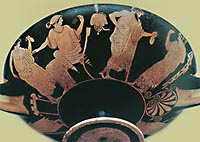

The only privilege a woman had a right to was her dowry. In this case she was known as epiproikos. The dowry was a sum total of money or objects of value, and it was transferred from the bride's family to the house of the bridegroom. If in kind, it had to be valued, so that the bride's family could get it back should the marriage be dissolved. |
The woman did not of herself have the right to inherit her
father's estate (his kleros). If, therefore, she had no
brothers or sisters, she acted as the means of transferring the
estate to the male relatives of the family. In such a case, she
was known as epikleros. The female heir had to be given in
wedlock to her nearest male relative, so that the estate could
stay in the family.
In Athenian law, the legal act that wound up
inheritance disputes was called diadikasia ('the ongoing
procedure'). The decision that settled differences between the
various suitors of a wealthy epikleros was termed epidikasia
('the final procedure').
 |
As for prostitutes, the city controlled their prices and taxed their gains. The hierodoulai - the temple prostitutes dedicated to a particular deity or and 'available' to temple visitors - presented their emoluments to their temple. There is no information on the hetairai except that they were paid for the recreation they provided. |
 |
 |
| | introduction | landowning-farming | trade | mines | | |||
| | state welfare | liturgies | private property | | |||
| |||